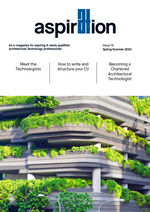 The architectural jobs market has gone through a lot of changes in the last few years, with the impact of the pandemic and Brexit greatly affecting the demand and supply of talent. One of the most notable developments was the strong rebound that occurred after the initial lockdowns in 2020. According to the RIBA Future Trends Survey, the workload index rose from -82 in April 2020 to +31 in June 2021, indicating a positive outlook for future work. Compared to previous recessions, however, where there would usually be a ready workforce to take up the new opportunities, firms found it surprisingly hard to find suitably qualified staff. Sadly, following Brexit, the UK no longer held the same appeal for the many European architectural staff who decided to leave during the pandemic.
The architectural jobs market has gone through a lot of changes in the last few years, with the impact of the pandemic and Brexit greatly affecting the demand and supply of talent. One of the most notable developments was the strong rebound that occurred after the initial lockdowns in 2020. According to the RIBA Future Trends Survey, the workload index rose from -82 in April 2020 to +31 in June 2021, indicating a positive outlook for future work. Compared to previous recessions, however, where there would usually be a ready workforce to take up the new opportunities, firms found it surprisingly hard to find suitably qualified staff. Sadly, following Brexit, the UK no longer held the same appeal for the many European architectural staff who decided to leave during the pandemic.
At the same time, inflation started rising rapidly in 2022 and in order to attract the best talent, architectural salaries also had to rise. According to our last salary survey, the average salary of Architectural Technicians and Architectural Technologists increased by around 12% compared to 2021. Firms were also very flexible towards remote working and job seekers could be lot more demanding in their negotiations.
Although workloads and salaries were increasing last year, architectural fees, however, were not. Too often it appears architectural practices have undercut their competitors to levels which in the long run are not sustainable and when projects inevitably get put on hold, the finances don’t stack up. This may in part be due to the increase in new practices that have set up over the last few years who initially have low operating costs and feel they can offer clients lower fees. For more established businesses, their greatest frustrations appear to be the stop-start nature of projects and 2023 has seen a number stall. Many will restart but practices will have to gamble on how long they can hold onto staff whilst waiting for projects to proceed to the next stage. With building costs rising far in excess of inflation during the last year, however, the profitability of many projects have been put in jeopardy. The biggest casualty has been HS2 that will now inevitably result in a large number of redundancies.
The balance between vacant jobs and job seekers has therefore started to shift and the candidate driven market of the last couple of years is coming to an end. With an increase in architectural staff looking for work, firms are now far more reluctant to offer such high salaries and are also being a lot more demanding about returning to pre-pandemic work practises. Although there are still firms offering flexible working, there is an obvious push to get staff back to the office where employers generally feel team working is more productive.
The recent increase in architectural CVs is however very sector specific and some areas are still very busy and seeing a shortage of qualified staff. The majority of candidates we are receiving have lots of experience within large scale infrastructure or developer housing projects which have been impacted by the rising interest rates. Most of our job opportunities though are working on high end private residential across the southeast where, post-Christmas, the effects of the mini budget have stabilised. The luxury end of the market is particularly buoyant and still struggling to resource projects with people who have the specialised sector experience. The smaller residential studios will also often be using Vectorworks whereas staff coming from larger AJ100 practices will probably prefer to use Revit.
With the cost-of-living crisis still biting and the recent salary increases waning, many people are looking to make the move client side or to a contractor where the overall package is often a significant jump from working within an architectural practice. These roles tend to be working as Design Managers, Technical Coordinators and Project Managers. Unfortunately, the number of vacancies within this sector is far smaller and therefore competition is significantly higher. They will invariably also be looking for people who have already gained 5-10 years of experience within practice.
The other popular move has been into the public sector which, although often has slightly lower salaries, does tend to offer a better work/life balance and pensions. With the impending government cuts, however, this option may be become more limited. With the rising tax burden in the UK, the final option many consider is to work abroad where often it can be far more lucrative. Projects like The Line in Saudi Arabia will be a popular draw for some, but the obvious moral issues will not be for everyone.
Although some of the above may sound quite challenging, compared to the last few years of Brexit and pandemic, the architectural industry has been through a lot worse and there is definitely light at the end of the tunnel.
Paul Chappell – Director of 9B Careers – Specialists in Architectural Recruitment
Download the latest aspirATion magazine at CIAT | aspirATion magazine (architecturaltechnology.com)